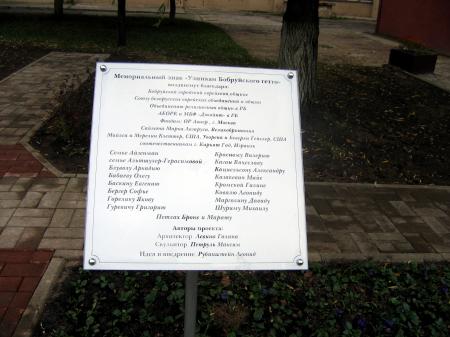Obj. ID: 48143
Modern Jewish Art Memorial sign to the prisoners of the Bobruisk Ghetto, Belarus, 2008

Official Name
мемориальный знак «Узникам Бобруйского гетто»
Translation: Memorial Sign "To the prisoners of Bobruisk Ghetto"
Who is Commemorated?
Prisoners of Bobruisk Ghetto
Description
The memorial is located on the site of the former ghetto in Bobruisk, in the middle of a round square that is visible, and accessible, from Bakharova Street.
The memorial takes the form of a wall built of granite blocks of varying colors. The wall has an attached relief depicting a map of streets with houses, where Jews once lived. The relief is divided into two by protrusion in the shape of a tree.
The granite blocks are inscribed in Belorussian. The letters are shaped like handwriting.
Inscriptions
On the granite blocks in Belarussian (material – silumin)
On the left side:
Няхай будуць
іх душы
ўплецены
вечны
вузел жыцця
Translation: May their souls be bound in the bundle of life [Translation in Belarussian of the traditional Hebrew formula written on gravestones]
On the right side:
1941
Вязням
Бабруйскага
гета
ліпень – лістапад
Яны любілі
жыццё
Translation: 1941 / To the prisoners / of Bobruisk / Ghetto / July - November / They loved life [author Leonid Rubinshtein (poet, chairman of the Jewish community in Bobruisk in 2008)]
Plaque indicating the sponsors and authors of the memorial sign installed on the right side of the monument.
In Russian:
Мемориальный знак «Узникам Бобруйского гетто»
воздвигнут благодаря:
Бобруйской городской еврейской общине
Союзу белорусских еврейских объединений и общин
Объединению религиозных общин в РБ
АЕОРК и МБФ “Джойнт” в РБ
Фондам: ОР Авнер, г.Москва
Саймона Марка Лазаруса, Великобритания
Майлса и Мерелин Клеттер, США, Уворена и Беверли Гейслер, США
Соотечественникам г. Кирьят Гад, Израиль
Семье Айзенман Красному Валерию
семье Альтшулер-Герасимовой Каган Вячеславу
Блуволу Аркадию Кацнельсону Александру
Бабаеву Олегу Казакевич Майе
Баскину Евгению Кромской Галине
Бергер Софье Ковалю Леониду
Горелику Якову Марголину Давиду
Гуревичу Григорию Шуриму Михаилу
Петлах Броне и Марату
Авторы проекта:
Архитектор Левина Галина
Скульптор Петруль Максим
Идея и внедрение Рубинштейн Леонид"
Translation: Memorial sign "Prisoners of the Bobruisk Ghetto" built thanks to: Bobruisk city Jewish community / Union of Belarusian Jewish Associations and Communities / Association of religious communities in the Republic of Belarus / JDC in the Republic of Belarus / Funds: OR Avner, Moscow / Simon Mark Lazarus, UK / Miles and Marilyn Kletter, USA, Uvorena and Beverly Geisler, USA / Compatriots Kiryat Gad, Israel / Family Aizenman Krasnyi Valery / family Altshuler-Gerasimova Kagan Vyacheslav / Bluvol Arkady Katsnelson Alexander / Babaev Oleg Kazakevich Maya / Baskin Evgeny Kromskaya Galina / Berger Sofia Koval Leonid / Gorelik Yakov Margolin David / Gurevich Grigory Shurim Mikhail / Petlah Bronia and Marat // Project authors: / Architect Galina Levina / Sculptor Maxim Piatrul / Idea and implementation Leonid Rubinshtein
Commissioned by
Bobruisk Jewish community, Union of Jewish organizations in Belarus, private donors
sub-set tree:
| Bakhapova Str. (улица Бахарова) Bobruisk Ghetto area
In January 1939, 26,703 Jews lived in Bobruysk, accounting for 31.7 percent of its total population. Jewish refugees from Nazi-occupied Poland soon increased this number. On June 28, 1941, Bobruysk was occupied by German troops. Only a small part of the Jewish population was able to evacuate itself to the Soviet hinterland. In early August 1941, a ghetto was established on the open space near the airfield in the southeastern part of the city, and Jews from Starye Dorogi, Slutsk, Krichev, and Glusk were brought there. The majority of Bobruysk Jewry was murdered in two operations carried out in September and November 1941. Between June and August 1942 about 1,500 Jewish men were sent from the Warsaw ghetto and incarcerated in a concentration camp near Bobruysk. Most of them were shot in the vicinity of Bobruysk. Bobruysk was liberated by the Red Army on June 29, 1944. [Untold Stories]
The local Jews started the memorialization in the 1960s.
The memorial dedicated to the prisoners of Bobruisk Ghetto was unveiled on October 19, 2008. The opening ceremony was attended by representatives of the regional authorities, the author of the Memorial, the Ambassador of the State of Israel, Jewish public organizations, rabbis, and local Orthodox and Catholic priests.
Memorial ceremonies take place on the site on January 27 and November 6-7 (the anniversary of the Bobruisk Ghetto's destruction).







